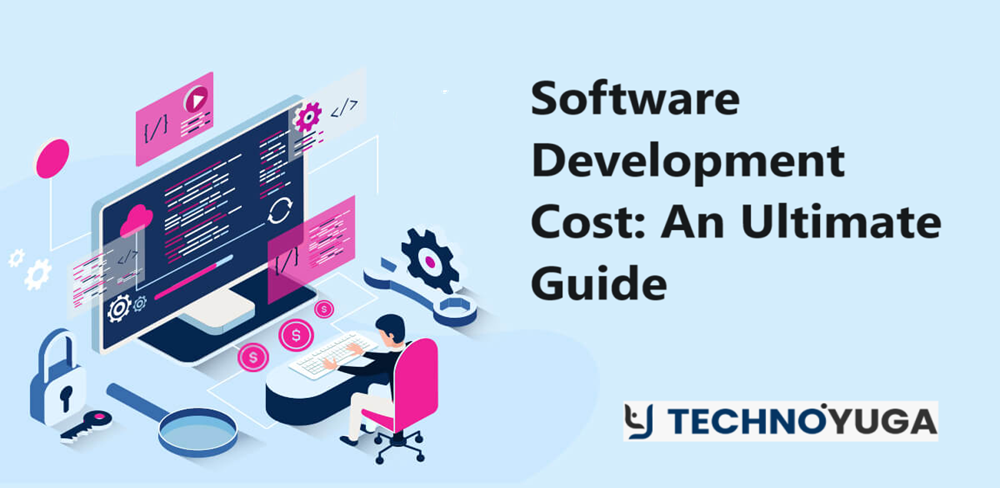Software development is a complex and dynamic process that involves creating, testing, and maintaining applications or websites. So, whether you’re a Startup founder, an entrepreneur, or a business leader looking forward to custom software development, understanding the costs involved is crucial for budgeting and planning purposes.
So, here in this comprehensive guide, the software development company experts have explained the various factors influencing software development costs. The professionals have also offered detailed insight into how to manage and optimize the cost of software development effectively. So, without any delay, let’s reveal the cost-affecting factors and more.
What is Software Development?
Software development is the process of designing, creating, testing, and maintaining computer programs and applications. It involves writing code using programming languages, frameworks, and tools to meet specific functionalities and user requirements. The process typically includes analyzing requirements, planning, coding, debugging, and optimizing for performance and usability. Collaboration, version control, and documentation are crucial aspects. Agile methodologies like Scrum and Kanban often guide the development process, emphasizing iterative, customer-centric approaches. The end goal is to produce reliable, efficient software that solves problems or fulfills needs in various domains such as business, entertainment, healthcare, and more.
What Are the Basics of Software Development Cost?
Before directly jumping into the process of capitalizing on software development cost, let’s begin with the basics of software development. It will help you know about the different types of costs associated with software development.
Types of Software Development Costs
Software development costs can be broadly categorized into three main types:
- Development Costs: Expenses associated with designing, coding, and testing the software.
- Operational Costs: Costs to deploy, operate, and maintain the software after development.
- Project Management Costs: Costs related to managing the project, including planning, coordination, and communication.
Cost-Affecting Factors that Influence the Budget of Software Development
Several factors influence software development costs, including:
- Project Scope and Complexity: The complexity and scope of the project significantly impact costs.
- Technology Stack: The choice of programming languages, frameworks, and tools affects costs.
- Team Structure and Skills: The expertise and size of the development team are crucial cost determinants.
- Timeframe: The duration required to complete the project influences overall costs.
What is the Estimated Software Development Cost?
Many business owners want to know the estimation of software development. So, here are the several methods that can help estimate software development costs, such as –
- Expert Judgment: Utilizing the experience and expertise of industry professionals.
- Analogous Estimation: Estimating costs based on similar past projects.
- Bottom-Up Estimation: Estimating costs for individual components and aggregating them.
- Parametric Estimation: Using statistical models based on historical data.
What Are the Factors Affecting Software Development Cost Estimation?
Although there is a long list of factors affecting the cost of software development. But, here the software development services experts have highlighted the three major factors impacting the software development cost estimation. They are –
- Requirements Clarity: Well-defined requirements lead to more accurate cost estimates.
- Change Management: Managing changes during the development process can impact costs.
- Risk Assessment: Identifying and managing risks helps in estimating contingency costs.
What Are the Different Strategies to Optimize Software Development Cost?
Here is a list of the top strategies suggested by the custom software development company professionals that could help you optimize cost the best way.
#Strategy 1 – Agile Methodologies
Utilizing agile methodologies like Scrum or Kanban can enhance cost-effectiveness by promoting iterative development and frequent client feedback.
#Strategy 2 – Offshoring and Outsourcing
Leveraging the global talent pool by offshoring or outsourcing development work can significantly reduce costs while maintaining quality.
#Strategy 3 – Minimum Viable Product (MVP) Approach
Developing a basic version of the software with essential features can validate the product’s market fit and reduce initial development costs.
#Strategy 4 – Open Source Technologies
Utilizing open-source tools and frameworks can lower development costs, as they are freely available and often well-maintained by the community.
What Are the Best Software Development Cost Management Strategies?
Are you looking for the best software development cost management strategies? Here are some of them, as explained by the web development experts.
#Strategy 1 – Transparent Communication
Maintaining clear and open communication with stakeholders throughout the project helps manage expectations and potential scope changes that can impact costs.
#Strategy 2 – Effective Risk Management
Identifying and managing risks proactively can prevent costly issues during the software development process.
#Strategy 3 – Regular Performance Monitoring
Tracking the project’s progress against the planned budget helps in identifying cost overruns early and taking corrective actions.
How Can Businesses Earn Profit From Software Development?
Being a business owner, everyone wants to know the benefits or profit of developing software. Right? Well, if you have already spent bucks on software development and are now wondering how to earn profit to balance the software development cost, the following techniques will help you. Without delaying further, let’s begin.
- Licensing and Subscription Models: License the software to other businesses or users, either through a one-time purchase or a subscription-based model. This can generate recurring revenue based on usage or a predetermined time period. In case you are seeking software development services, ask the experts to incorporate such models.
- In-App Purchases and Upgrades: Provide a free or basic version of the software and offer in-app purchases for additional features, upgrades, or premium content. Users can choose to enhance their experience by buying these add-ons.
- Advertising and Partnerships: Integrate advertising within the software or partner with other businesses to display their products or services. Earn revenue based on the number of impressions, clicks, or conversions generated through the software.
- White Labelling and Reselling: Allow other businesses to rebrand and resell the software as their own. Charge a licensing or partnership fee for the white-labeled version, enabling the partner to sell it under their brand. Undoubtedly, the custom software development cost will be high, but the decision will be definitely worth it.
- Maintenance and Support Contracts: Provide ongoing maintenance, updates, and technical support services to users for a fee. This can include troubleshooting, bug fixes, and help desk support. Adding mobile app support and maintenance contracts will generate more profit than ever.
- Crowdfunding or Fundraising: Use crowdfunding platforms to finance the development of new software products. Offer early access or special perks to backers as an incentive.
- Partnerships and Collaborations: Collaborate with other businesses or developers to create integrated solutions. Share revenue generated from the joint product or service.
By employing one or a combination of these strategies, businesses can effectively monetize their software development efforts and achieve sustainable profitability while capitalizing on software development cost. Now that you are well-versed with the tricks, implement them the right way and make your business software the best way to earn more profit and sales.
Summing Up!!!
Understanding software development costs is essential for successful project planning and execution. By considering the project’s scope, technology stack, and team structure and employing effective estimation and management strategies, you can optimize costs and achieve a successful software development project within budget.
Remember, effective cost management is not just about cutting expenses but about delivering value efficiently and ensuring the long-term sustainability of your software. Stay informed, plan meticulously, and adapt to changes to navigate the landscape of software development costs effectively.
FAQs on Software Development Cost
What Factors Influence the Cost of Software Development?
The cost of software development is influenced by various factors, including project complexity, features and functionality, technology stack, development team size and location, project timeline, third-party integrations, testing requirements, and ongoing maintenance and support.
How Does Project Complexity Affect Software Development Costs?
Project complexity significantly impacts development costs. Complex projects with intricate features, advanced functionalities, and extensive integrations will require more time and effort to develop, resulting in higher development costs.
What Role Does the Technology Stack Play in Determining Development Costs?
The technology stack, including programming languages, frameworks, and tools, can impact development costs. Some technologies require specialized skills, which could affect labour costs. Additionally, licensing fees for certain technologies can also influence the overall cost.
How Does the Size And Location of the Development Team Affect Costs?
The size and location of the development team can impact costs. In regions with higher labour costs, having a larger team may increase expenses. Conversely, outsourcing to regions with lower labour costs can provide cost savings without compromising quality.
Are There Ways to Manage Software Development Costs Effectively?
Yes, there are several strategies to manage software development costs effectively. These include defining clear project requirements, conducting thorough planning, prioritizing features based on business needs, utilizing open-source technologies, optimizing development processes, and considering agile methodologies for flexibility and cost control.
How Can I Estimate Software Development Costs Accurately?
Accurate estimation involves detailed project analysis, defining requirements, breaking down tasks, considering historical data, and consulting with experienced software developers. It's essential to account for all aspects of development, testing, deployment, and ongoing maintenance to ensure a comprehensive estimate.
What Are Some Cost-Saving Tips for Software Development Projects?
Cost-saving tips include leveraging reusable components or open-source libraries, opting for cloud services instead of building infrastructure, focusing on essential features first, outsourcing non-core tasks to reduce labour costs, and effectively managing project scope to avoid unnecessary expenses.
How Does Iterative Development Impact Software Development Costs?
Iterative development, such as the agile approach, can help manage costs by allowing for continuous feedback and adjustments throughout the development process. It helps in identifying and addressing issues early on, preventing costly rework that may arise in a linear development model.
What Ongoing Costs Should Be Considered After Software Development?
Ongoing costs include maintenance, updates, hosting, server expenses, licensing fees, support, and potential future enhancements. It's important to factor in these costs during the initial budgeting to ensure a comprehensive view of the long-term financial implications.
Can You Provide An Approximate Cost Range For a Typical Software Development Project?
The cost of a software development project can vary widely based on the factors mentioned earlier. Small projects may range from a few thousand to tens of thousands of dollars, while large, complex projects can exceed several million dollars. It's essential to conduct a detailed analysis and estimation for an accurate cost range specific to your project.






